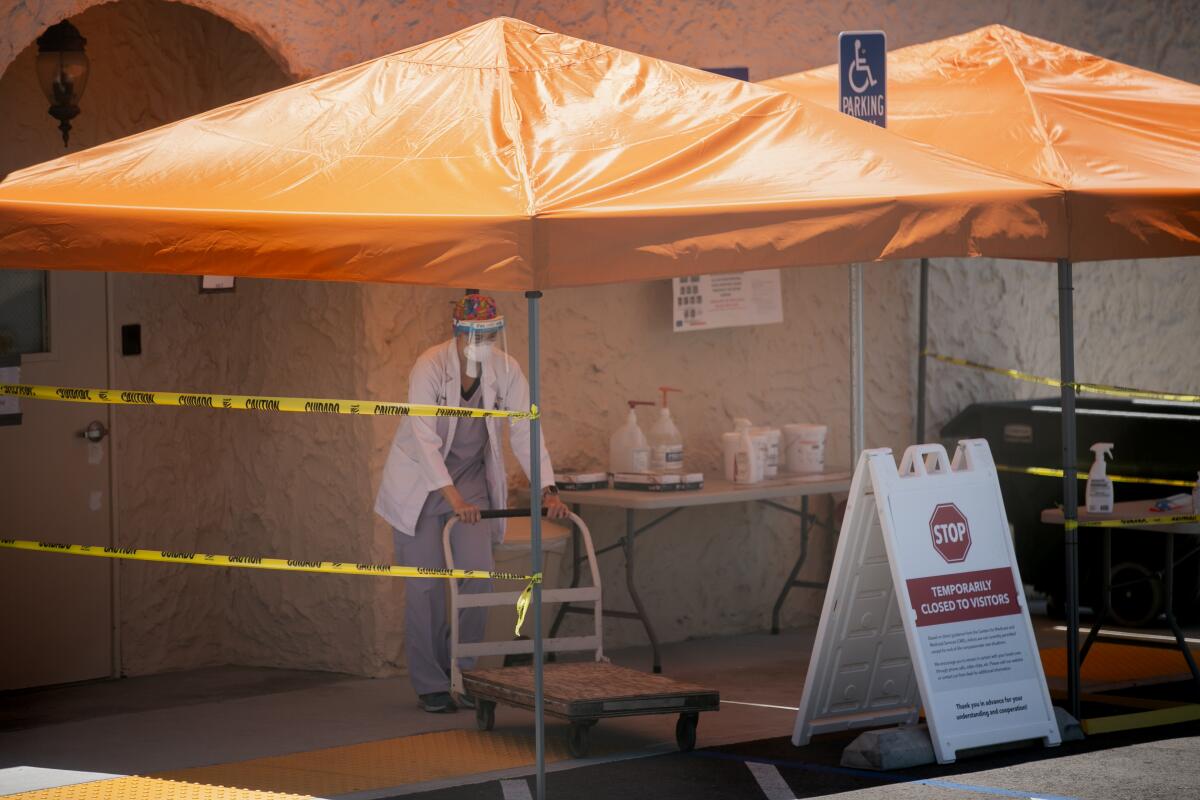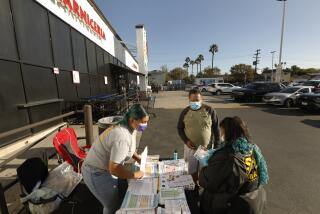July is now the deadliest month of the pandemic in San Diego County

- Share via
With 14 additional COVID-19-related deaths announced Tuesday, July became the deadliest month for the coronavirus pandemic in San Diego County since it started in mid-February. The news came amid fresh requests for deeper information on how local communities of color are being disproportionately affected by the disease.
According to county records, 161 of the region’s 547 total COVID-19 deaths occurred in July, 12 more than were reported in May, the previous month with the most fatalities. The median age of those who have died of the disease is 78, with the vast majority having other health problems that made them more susceptible to severe illness.
Due to reporting delays, none of the 14 deaths reported to the public Tuesday actually occurred on July 28. Dates ranged from Sunday back to July 17.
Thus far, July 13 has been the deadliest single day in the county with 12 deaths reported, followed by July 2 with 11. April 5 and July 8 both had 10.
On the same day, the county health department reported 498 additional coronavirus cases, a number that brought the region’s 14-day average of positive tests to 5.7%. Statewide, the comparable rate was 7.5%. Across California, 73 additional COVID-related deaths were reported Tuesday.
Eight additional community outbreaks also appeared in Tuesday’s report, including five in local restaurants, one in a gym, one in a nail salon and one in a residence. An outbreak is three or more cases from different households that visited a common location.
As deaths have continued to mount, some in the community are asking for a clearer picture of the trends that have caused deaths and case rates to increase in some parts of the county more quickly than others.
On Tuesday, Shane Harris, founder of the civil rights organization People’s Alliance for Justice, asked the county to produce deeper demographic data on testing and positive case investigation in the county. To date, the public health department has provided the demographics of those who test positive but not for all of the 575,264 test results returned so far.
Knowing the breakdown of all tests conducted, Harris said, would shed light on whether current outreach efforts are succeeding in making sure that the demographic groups hardest hit by the pandemic are getting access to enough resources.
“If we don’t know who is being tested, we can’t even argue about the issue of where resources should be put,” Harris said.
He said his organization began asking the county for such demographic testing breakdowns in May but has not received the information so far. A county official said the information was being compiled and would be released soon.
Early Tuesday evening, the county did provide a demographic breakdown of its contact tracing and case investigation staff, another item that Harris requested. The breakdown generally shows that Latinos are about 25% of the 565 investigation and tracing workforce hired so far, a number that is about 10 percentage points lower than their representation in the overall community. Latinos have been, by far, the most disproportionately hit by the pandemic, making up 61% of the region’s 28,005 confirmed cases.
Though the county’s workforce of investigators and tracers are significantly more diverse than the county as a whole — with 52% listed in “nonwhite” categories — Harris said the gap for Latinos indicates that there is more work to do on the diversity front. He said many want more information on what the county is doing to ensure that those who call people who test positive for the coronavirus have the cultural knowledge that can help them get the most accurate and timely information over the phone.
“At the end of the day, they are going to have to confront how they are culturally preparing people to do this work in our communities,” Harris said.
The county also shed fresh light on the number of coronavirus-related hospitalizations Tuesday.
On Monday, the health department released a chart showing that hospitalizations topped out at 529 Sunday, a number that would have been a new single-day record. But that trend did not track with generally flat demand reported by several of the region’s healthcare leaders.
Officials revised recent hospitalizations downward in Tuesday’s report, dropping Sunday’s total from 529 to 458 confirmed or suspected COVID patients in hospital beds. Monday’s total was 463, fitting into the general pattern of hospitalizations in recent weeks.
It appeared Monday that a simple math error led to the sudden jump in cases. Mike Workman, communications director for the county, said in an email Tuesday evening that he was not sure what happened but added that it was “very likely we added something wrong” trying to compensate for the absence of several local hospitals in recent state-level hospitalization reports.
A new set of federal rules also requires hospitals to remove patients from COVID counts once they have tested negative, even if they continue to occupy a hospital bed. In an emailed statement Tuesday afternoon, the California Department of Public Health said it will continue to use the previous formula for hospitalizations.
“California continues to require hospitals to report the same level of detail they have been providing, and we will continue posting the same data daily,” the statement said. “California also will submit data to the federal Department of Health and Human Services in accordance with their newly-issued requirements.”
More to Read
Sign up for Essential California
The most important California stories and recommendations in your inbox every morning.
You may occasionally receive promotional content from the Los Angeles Times.














